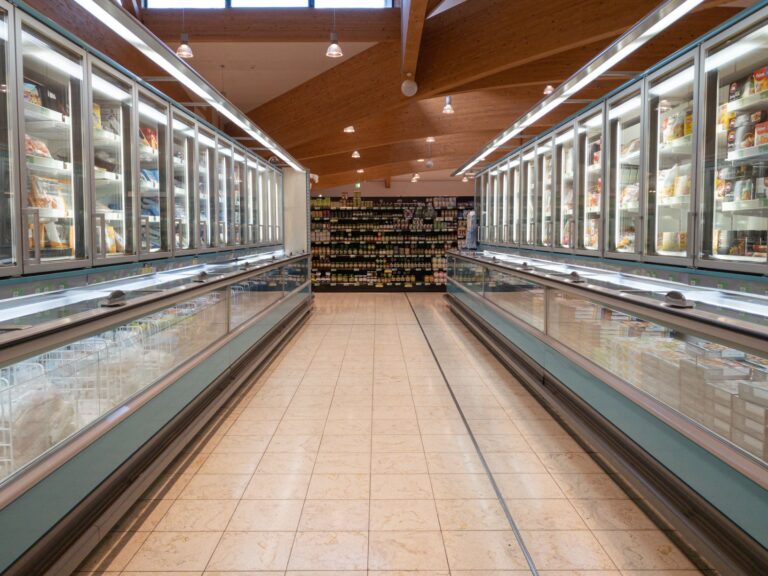To make this measure more effective and tailored to the specific context of your company, we recommend that you first perform an overall analysis of your energy situation.
Installation of a transcritical CO2 refrigeration system
The project involves replacing an existing conventional, centralised, or direct expansion installation with a refrigeration system using CO2 as a fluid which is transferred in a transcritical or subcritical cycle (cascade or refrigerant) to the units diffusing the cold (refrigerated units, cold room evaporators, etc.) for a positive or negative application, or both.
This system applies to existing commercial buildings, particularly food distribution premises. This includes spaces intended for the display or self-service of fresh products for the public, such as hypermarkets, supermarkets, and small food stores. Drive-through facilities and click and collect points allowing the public to pick up their purchases without actually entering the store (the “drive-through” concept) as well as refrigerated warehouses.
Setting up this new technology will allow the company to save electricity, while reducing its carbon footprint. However, implementing this measure can be complex and requires the temporary shutdown of production during the technical installation stage.
This technology will replace positive or negative refrigeration facilities using R404A as a refrigerant. These refrigeration installations are centralised or decentralised (direct expansion) and often, the positive and negative refrigeration circuits are separate. It is important to know that R404A is a widely used refrigerant that will no longer be available on the market from 2030.
In a subcritical CO2 refrigerant plant, the condensation process takes place in a two-phase refrigerant, the vapours of which are recondensed by a primary ‘synthesis’ fluid or ammonia, to produce refrigeration at a positive temperature.
In a subcritical CO2 cascade system, condensation takes place in cascade on a production unit using a primary “synthesis” fluid or ammonia for negative temperature refrigeration. In a transcritical CO2 system (booster), condensation takes place in direct expansion using CO2 as refrigerant in a transcritical cycle. In this latter configuration, the plant performance can be optimised by installing parallel compression and ejectors
Energy and environmental impact
The use of subcritical or transcritical CO2 offers several advantages.
First, the refrigeration cycle is optimised compared to a standard system, which limits the space requirement. This system also offers the possibility of recovering a significant quantity of heat during desuperheating. In addition, the use of a weak fluid contributes positively to lessening global warming.
Estimated annual electrical savings can reach up to 20% with CO2 booster technology and up to 36% using CO2 booster technology combined with parallel compression and ejectors.
Source: ADEME. (January 2020). Refrigeration plant using subcritical or transcritical CO2. File BAT-EQ-117. Association Technique Énergie Environnement (ATEE).
State subsidy application
State subsidies
Please note: any application for government or non-government subsidies must comply with the “incentive effect”, subject to compliance with the subsidy conditions.
To ensure that the ‘incentive effect’ is respected, no binding commitment (signing a quotation; paying an advance) may be made BEFORE submitting the application file or receiving the agreement in principle from the State or the electricity and natural gas supplier following an application for subsidies.
Temporary environmental impact aid
Extended “SME Packages Sustainability” aid scheme, to give companies greater incentives to invest in measures that significantly improve their environmental impact. Investments under this climate protection measure amount to 70% for small enterprises, 60% for medium-sized enterprises and 50% for large enterprises, for projects costing more than €7,500, with a maximum subsidy of €100,000.
- Verification of company eligibility and costs: Ministry of the Economy (Department for Support to SMEs)
- Application deadline: 30 June 2025
- For any questions:
- Chambre des Métiers for the trades (Chamber of Skilled Trades and Crafts)
- Chamber of Commerce for companies in the non-craft sectors
- Financial Aid for small and medium-sized enterprises covering up to 70% of eligible costs for the implementation of a project aimed at reducing the environmental impact. The eligible project budget must be in a range from 3.000 € to 25.000 € excl. VAT.
- For more information:
- Chambre des Métiers for craft companies
- Chamber of Commerce for businesses in the non-craft sectors
Environmental protection scheme – Investment aid for the protection of the environment
- Verification of company eligibility and costs: General Directorate for Industry, new Technology and Research
- Support in drawing up the subsidy application file prior to submission to the Ministry of the Economy
- For any questions: Luxinnovation
- More information and recommendations for companies on investing in the environment are available in the Guide simplifié pour les entreprises
- Support in drawing up the subsidy application file prior to submission to the Ministry of the Economy
N.B. State subsidies cannot be combined for the same project
Subsidies from electricity and natural gas suppliers
Since 2015, natural gas and electricity suppliers are required to make energy savings for consumers under the obligation scheme. Since then, energy suppliers have been offering support and advice, as well as subsidy programmes for consumers to implement energy efficiency measures.
The following suppliers offer this service for companies:
N.B. Supplier subsidies can be combined with any state subsidies for the same project.
